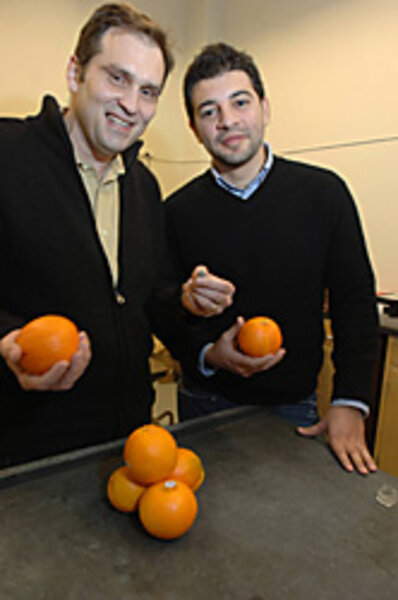Industry scrambles to find a 'greener' concrete
Loading...
We drive our cars on it, we build skyscrapers with it.
But concrete, one of the most common building materials in the world, has an ugly secret: It's a major source of carbon dioxide (CO2) emissions, which contribute to global warming.
Roughly 5 to 10 percent of global CO2 emissions are related to the manufacture and transportation of cement, a major ingredient of concrete.
With cement production expected to grow exponentially in coming decades, the industry is trying to address its environmental challenges.
"There is not one single cement company on this planet that is not thinking about how to [reduce emissions]," says Franz-Josef Ulm, a professor of civil engineering who researches concrete at the Massachusetts Institute of Technology in Cambridge, Mass.
The manufacture of cement is relatively efficient when compared with other building materials, such as steel and wood. The problem is the scale at which it's produced – roughly 2.4 billion tons in 2006 and growing, Professor Ulm calculates.
"But there is also a great advantage to the mass production," Ulm says. "Any small change you make to it has a big impact [on CO2 emissions]."
Worldwide, manufacturers are experimenting with using organic waste materials as a substitute for some of the cement used in concrete. These materials can replace up to 25 percent of the cement in the mix. Less cement means less greenhouse gas produced.
A few coal-rich nations use fly ash, a residue created when coal is burned, as a supplementary cementing material. Brazil's excess of bagasse, the dry pulpy residue left after the extraction of juice from sugar cane, has proved a reliable composite in concrete. Likewise, the fine gray-white ash of rice husks, chemically similar to cement, is increasingly used as a substitute ingredient in Asia.
Despite these regional successes, some industry researchers doubt they are the answer.
"Rice husks are really not available worldwide in amounts that will make a difference," says Claus Pade, senior consultant at the nonprofit Concrete Centre at the Danish Technological Institute in Copenhagen.
Italy's Italcemente is the world's fifth-largest cement producer. It is looking beyond reducing CO2 emissions by creating a cement that actually breaks down airborne pollutants.
While Italcemente's smog-eating cement has been used in Europe for several years, it was released in the United States only in 2007 under the name TX Active. It contains titanium dioxide, which, in the presence of sunlight, acts as a photocatalyer, hastening the decomposition of such pollutants as nitrogen oxides, sulfur oxides, and ozone. TX Active also keeps a building shiny white – a quality admired by architects – by preventing the buildup of pollutants on the surface.
Research suggests that if 15 percent of the surface area of Milan, Italy, were covered in TX Active, air pollutants there could be reduced by 50 percent.
When weighing the environmental effects of concrete, some other benefits need to be included, says Rick Bohan of the Portland Cement Association (PCA), a nonprofit trade group based in Skokie, Ill. For example, the insulation provided by concrete walls combats greenhouse-gas emissions by reducing the energy needed for heating and cooling a building by up to 40 percent compared with wood- and steel-frame structures, according to PCA research.
"As people begin to recognize just how much more sustainable concrete is in terms of saving energy, we're going to see cement demand and production go up," Mr. Bohan says.
No easy replacement for cement is on the horizon. No other known material is as abundant, accessible, and effective as limestone, the key ingredient in cement.
The vast majority of CO2 created during cement production is from the energy needed to incinerate limestone in order to change its chemical structure, a procedure called calcination. Scientists now are studying the structure of concrete molecules to try to find ways to create the same strong concrete, but at a much lower temperature.
Ulm points out that the structure of human bones, at the molecular level, is similar to that of concrete. While cement must be heated to 1,200 degrees C (2,200 degrees F.) before it achieves strength and structure, bone is formed at 37 degrees C (98.6 degrees F.).
"That makes one think that nature can create at 37 Celsius a material that has similar properties as cement," Ulm says. "Can we mimic that?"





